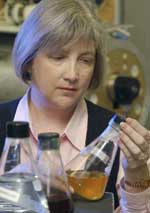 There are some headlines you just can’t ignore.
There are some headlines you just can’t ignore.
Like this one from the BBC today.
Nasa jubilant at urine solution
If you haven’t been following this closely, NASA is testing a system of providing drinking water to astronauts that is filtered from their urine. And if you have been following this closely, well, don’t tell me you haven’t been thinking about this because I know you have.
“Not to spoil anything, but I think up here the appropriate words are ‘Yippee!’,” space station Commander Mike Fincke told mission control early on Tuesday morning.
He supervised work on the malfunctioning water regeneration system – which distils, filters, ionises and oxidises wastewater including urine, perspiration and bath water, into drinkable water.
Nobody’s taking a swig of anything yet. The sampled brew will be tested by NASA when the astronauts return. But let’s be indelicate here for just a moment in the interest of science. Suppose this thing works, and the thing spits out lovely drinking water in bottles that say “Pluto Springs.” What if at some point in the future, it breaks again. How will they know?
This concept is not limited to space. More and more communities are considering tapping their sewage treatment plants as a source of drinking water.
In California, a plant is already working, as described by the New York Times in an August article:
When you flush in Santa Ana, the waste makes its way to the sewage-treatment plant nearby in Fountain Valley, then sluices not to the ocean but to a plant that superfilters the liquid until it is cleaner than rainwater. The “new” water is then pumped 13 miles north and discharged into a small lake, where it percolates into the earth. Local utilities pump water from this aquifer and deliver it to the sinks and showers of 2.3 million customers. It is now drinking water. If you like the idea, you call it indirect potable reuse. If the idea revolts you, you call it toilet to tap.
